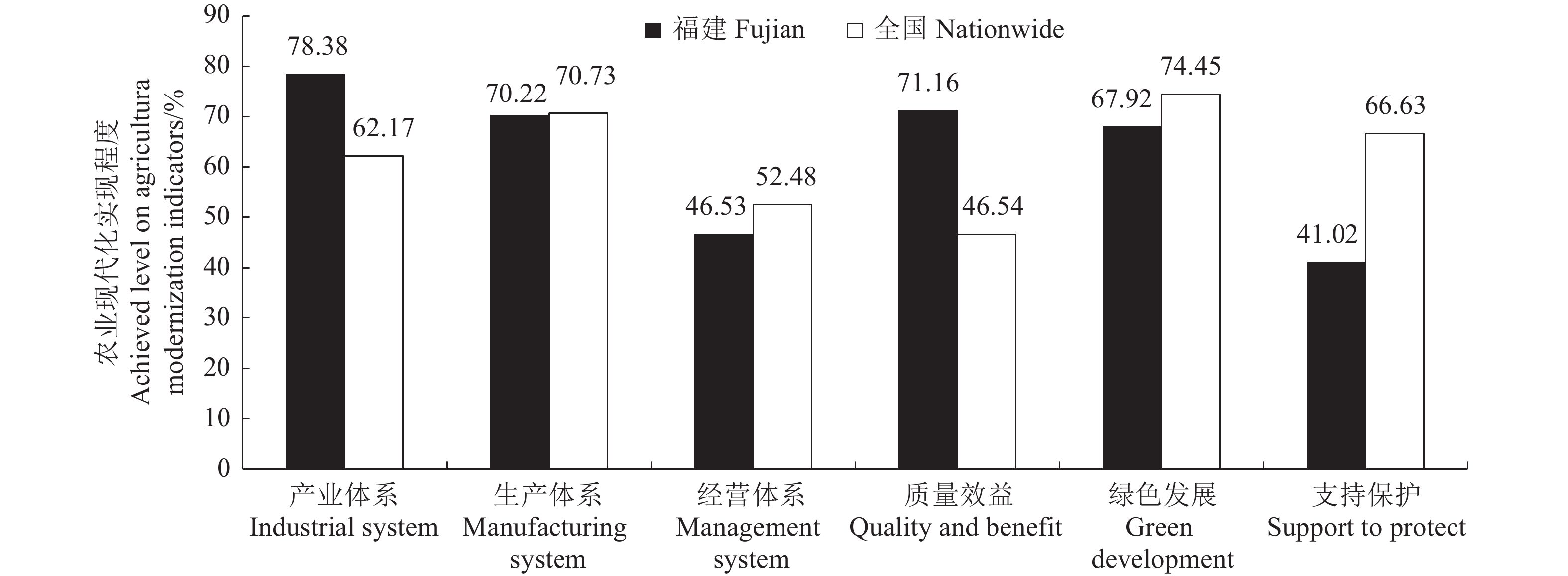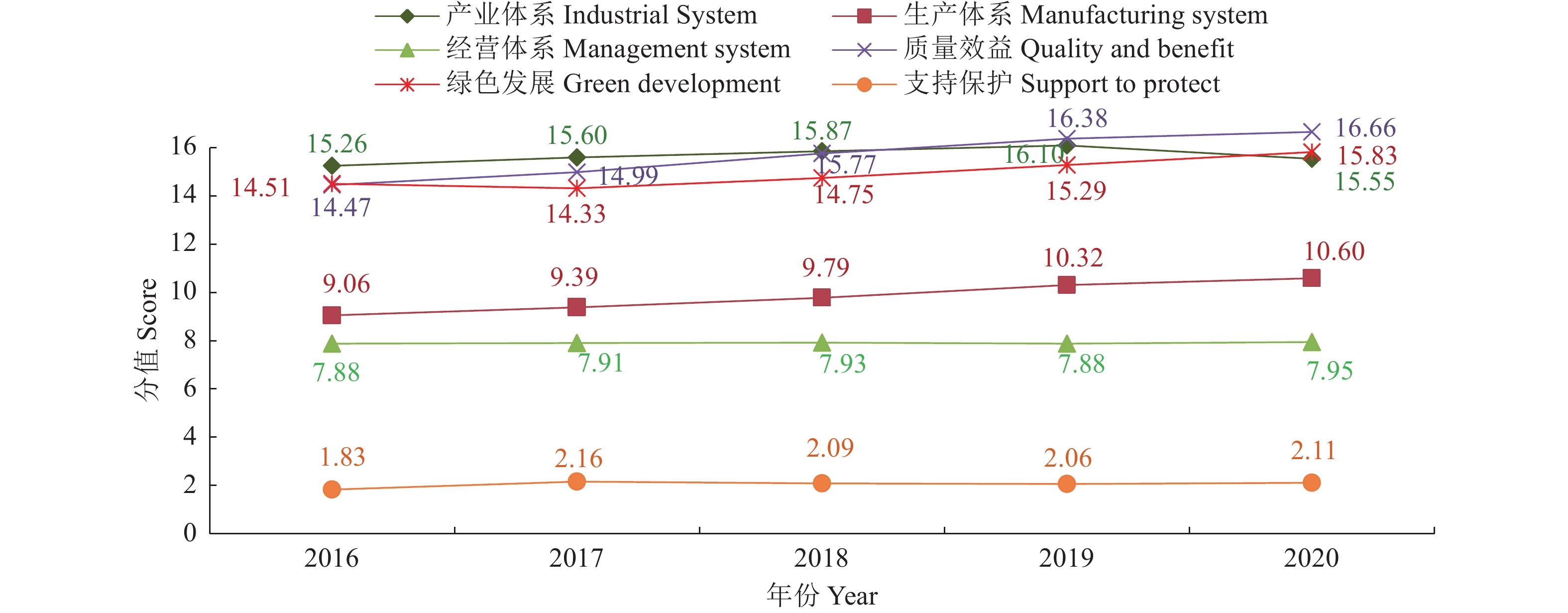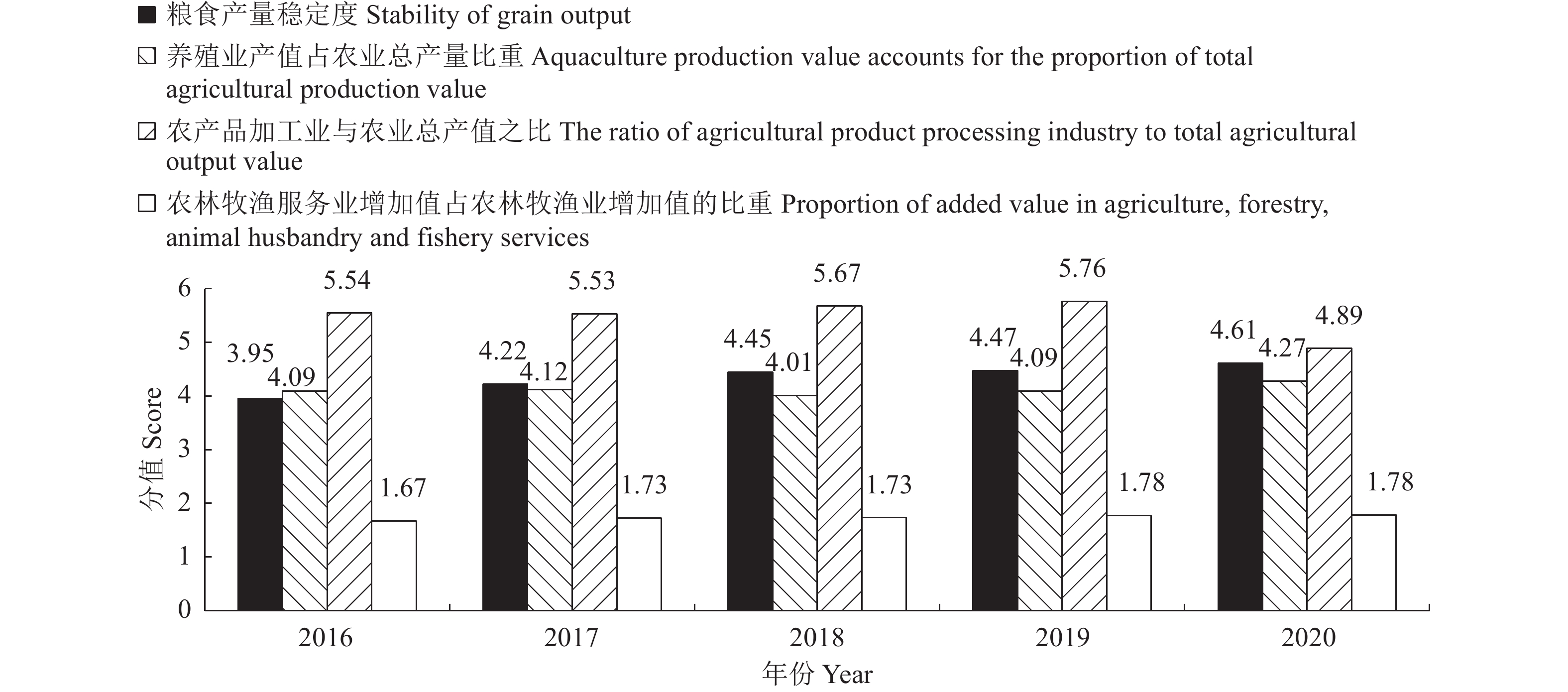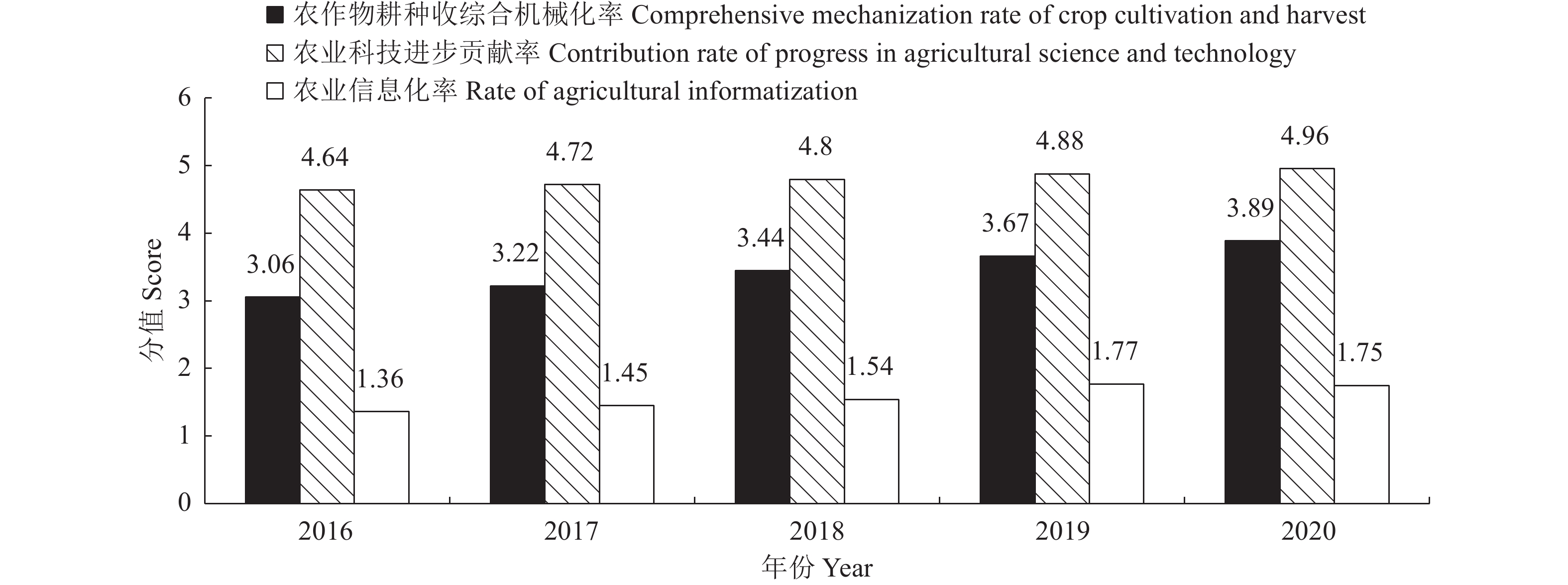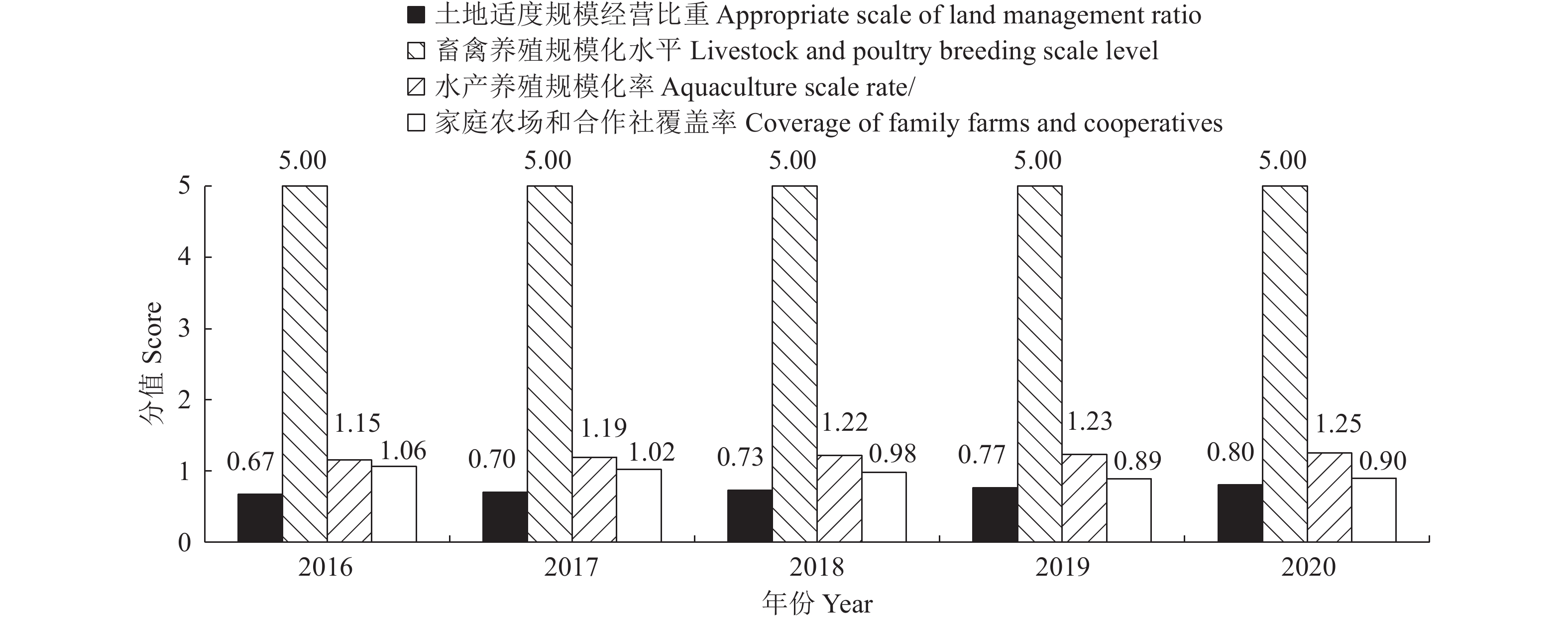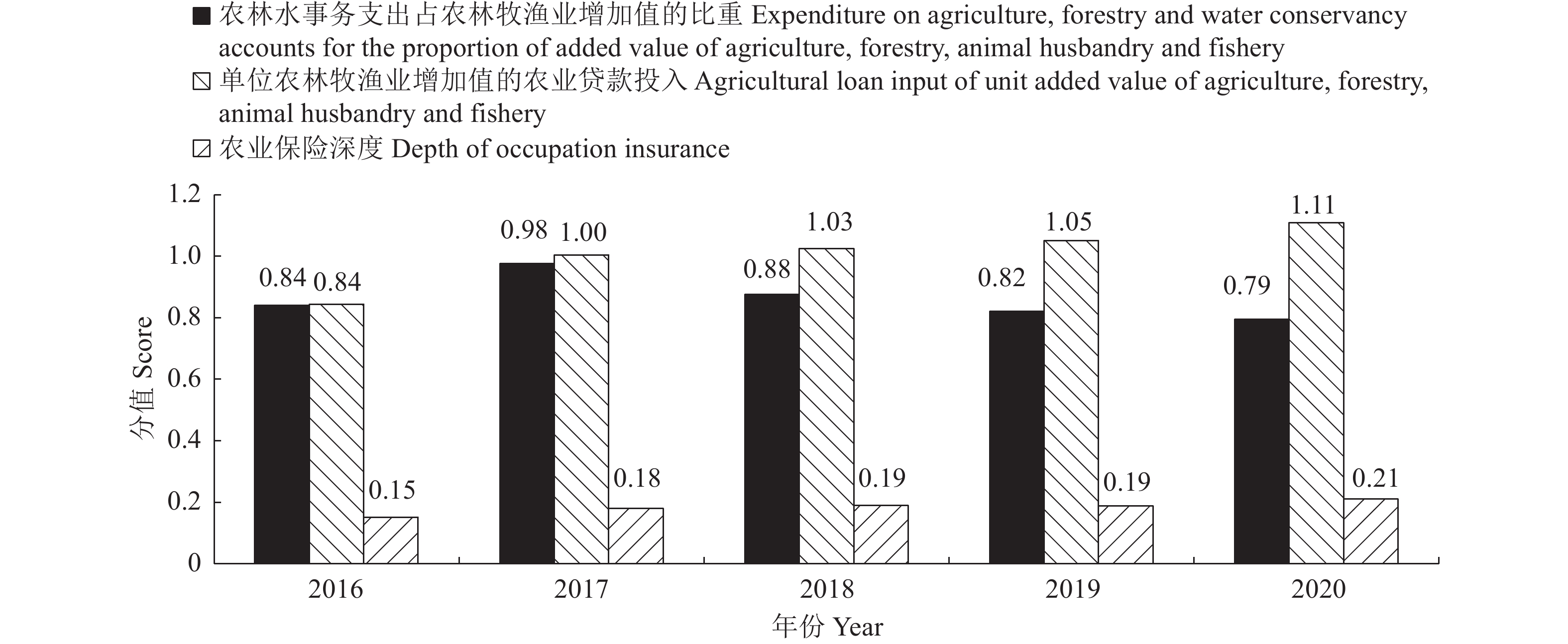Assessment and Strategy on Agricultural Modernization in Fujian
-
摘要:目的 评价福建农业现代化发展水平和制约因素,提出推进农业现代化的实施路径和发展策略,为新发展阶段福建加快推进农业现代化和全面推进乡村振兴提供决策参考。方法 运用综合指数法、层次分析法和目标值法,从产业、生产、经营三大体系和高效、绿色、支撑三大目标,构建6个一级指标和24个二级指标的农业现代化发展评价指标体系,测度“十三五”时期福建和全国农业现代化实现程度。结果 “十三五”期间,福建农业现代化平均综合得分为66.07分,高于全国平均水平(61.21分),已迈入转型跨越中期阶段(全国平均处于转型跨越初级阶段);农业现代化水平呈现稳步上升趋势,年均增长2.18%(略低于全国2.64%的增长率)。分指标水平测度显示,产业体系和质量效益实现程度为78.38%和71.16%,分别比全国高26.07%和52.90%。生产体系、经营体系、绿色发展和支持保护实现程度分别为70.22%、46.53%、67.92%和41.02%,分别比全国低0.73%、11.33%、8.77%和38.43%。福建农业现代化发展优势主要体现在农业生产效率较高、农业产业结构较合理、农产品加工业较发达、资源集约化利用程度较高等方面;而土地规模化经营水平低、农业组织经营主体弱小、农产品安全还有待提高、财政金融支持力度有限等是主要制约因素。建议 未来推进福建农业现代化均衡发展的重点方向是:加大高标准农田改造提升力度,提高特色经济作物种植能力,加强新型经营主体和社会化服务组织培育,强化绿色防控技术推广和完善农产品质量安全体系,提高财政支农力度和优化支农资金结构,提高农业保险补贴水平和扩大补贴范围。Abstract:Objective Means to evaluate the progress and strategies to overcome obstacles in modernizing Fujian agriculture were studied.Method The methods of comprehensive indexing, analytical hierarchy process (AHP), and target value were applied to establish an assessment system that could quantify the progress of the agricultural modernization taking place in China. Six first tier and 24 second tier indicators from the perspectives of industry, production, and management with the aims of being efficient, green, and supportive were employed in the evaluation system. Accordingly, the achievement levels realized by the province and the nation during the period of the 13th Five-Year Plan were analyzed.Result The average scores on the modernization in the 5-year period were 66.07 for Fujian and 61.21 for the nation. The levels were in the medium transformation stage for the province and in the primary stage for the country. The province had a lower average annual growth rate of 2.18% than 2.64% of the nation. The sub-index on industry for the province was 78.38%, which was 26.07% higher than that for the nation; and that on realization of quality and benefit, 71.16%, which was 52.90% higher than that for the nation. The indices on production, management, green practices, and supportive roles for Fujian were 70.22%, 46.53%, 67.92%, and 41.02%, respectively, which were 0.73%, 11.33%, 8.77%, and 38.43%, respectively, below the national levels. High production efficiency, functional organization, advanced processing facilities, and intensive resource utilization helped the modernization in Fujian. On the other hand, the province faced shortcomings on the relative insufficiencies in large-scale land management, managerial body, product safety, and financial support.Suggestion To promote the balanced development of modern agriculture in Fujian in the future, following measures were recommended: (1) developing high-standard farmlands and well-managed cultivated lands, (2) promoting cultivation of specialty cash crops, (3) nurturing establishments of new business and social service organizations, (4) enhancing research and applications of green preventive and control technologies, (5) enforcing product safety, (6) increasing financial support with an efficient operating system, and (7) expanding insurance coverages and supplement to agriculture related operations.
-
0. 引言
【研究意义】芦笋(Asparagus officinalis L.)又名石刁柏,是百合科(Liliaceae)天门冬属(Asparagus)多年生宿根植物,具有抗肿瘤和抗氧化等功效,是世界公认的高级保健蔬菜,享有“蔬菜之王”美誉[1−2]。芦笋茎枯病由天门冬拟茎点霉菌[Phomopsis asparagi(Sacc.)Bubak]侵染引起,主要为害芦笋茎秆,在中国、日本、泰国和印尼等亚洲国家芦笋种植区每年均有发生,严重影响芦笋的产量和品质[3−4]。目前,施用杀菌剂是防治芦笋茎枯病的有效手段,但面临着病原菌抗药性、食品安全和环境污染等问题[5]。利用作物品种的抗病性是防治作物病害最经济、有效和安全的措施[6]。芦笋是多年生作物,生产周期长,一次种植可采收10年,建立快速准确的芦笋抗茎枯病鉴定方法,选育抗病品种,对芦笋产业健康发展具有重要意义。【前人研究进展】开展品种抗病性鉴定是选育作物抗病品种的重要一环。我国对水稻、小麦、玉米和大豆等大宗作物的主要病害都建立了稳定可靠的抗病性鉴定方法,形成了国家作物品种抗病性鉴定技术规程[7−8]。在芦笋抗茎枯病的抗性鉴定方面,Sonoda等[9]报道了一种芦笋茎部接种的抗病性鉴定方法,但操作复杂、用时长、受环境条件影响大、重复性差。杨迎青等[10]采用苗期人工接种的方法鉴定了31份芦笋种质资源的抗病性水平,缩短了芦笋抗茎枯病鉴定的时间。阮宏椿等[11]采用苗期人工接种的鉴定方法测定了9个主栽品种对芦笋茎枯病的抗病性。苗期人工接种法具有鉴定结果稳定的优点,但仍需要完成播种、定植等繁杂工作,占用温棚面积大,耗时较长,难以针对大批量品种或育种材料开展抗病性鉴定。【本研究切入点】采用田间自然诱发或苗期人工接种法鉴定芦笋的抗病性,工作量大、耗时长,难以快速从大量种质资源中筛选出抗性材料。芦笋抗茎枯病快速准确鉴定方法还有待深入探讨。【拟解决的关键问题】本研究拟通过评价芦笋茎枯病菌毒素浸种法和浸根法、分生孢子悬浮液浸种法和分生孢子悬浮液灌根法等4种方法与田间自然诱发法对供试芦笋品种抗病性鉴定结果的一致性,建立芦笋抗茎枯病快速准确鉴定的新方法,为芦笋抗病育种和茎枯病的防治提供技术支撑。
1. 材料与方法
1.1 供试材料
供试菌株:供试芦笋茎枯病菌菌株FJ58采集自福建省莆田市涵江区庄边镇吉云村,由福建省农业科学院植物保护研究所分离鉴定,测定致病性并保存。
供试芦笋品种:格兰德、佳芦1号、早佳1号、丰岛1号、华淼、TC和UC157F2(感病对照品种),由福建省农业科学院植物保护研究所收集并保存。
供试培养基:马铃薯葡萄糖琼脂培养基(PDA培养基),取200 g马铃薯进行切片,加水煮沸20 min,过滤,上清液加入葡萄糖20 g、琼脂粉16 g,加热至琼脂粉完全溶解,加水定容至
1000 mL,在121 ℃下高压湿热灭菌25 min。马铃薯葡萄糖培养基(PDB培养基),取200 g马铃薯进行切片,加水煮沸20 min,过滤,上清液加入葡萄糖20 g,加水定容至1000 mL,在121 ℃下高压湿热灭菌25 min。1.2 方法
1.2.1 芦笋茎枯病菌孢子悬浮液的制备
芦笋茎枯病菌孢子悬浮液的制备参照杨迎青等[10]的方法 ,并稍作修改。将保存于滤纸片上的芦笋茎枯病菌菌株FJ58转至PDA培养基平板上,28 ℃培养5 d,用直径5 mm的打孔器在菌落边缘打取菌饼,将菌饼转入PDA培养基平板,28 ℃培养14 d,用毛刷和适量无菌水洗下分生孢子器,用灭菌镊子捏碎分生孢子器,释放分生孢子,过滤后血球计数板测定分生孢子浓度,分别配制成1.0×103、1.0×104、1.0×105个孢子·mL−1的分生孢子悬浮液,置于4 ℃冰箱保存,备用。
1.2.2 芦笋茎枯病菌毒素的制备
参照李俊萍等[12]的方法,并稍作修改。将芦笋茎枯病菌菌株FJ58转至PDA培养基平板上,28 ℃培养5 d,用直径5 mm的打孔器在菌落边缘打取菌饼,将菌饼转入装有PDB培养基的三角瓶中,28 ℃、150 r·min−1振荡培养7 d,用灭菌滤纸过滤后收集滤液,并用细菌过滤器(0.22 μm)过滤,收集芦笋茎枯病菌粗毒素液。将芦笋茎枯病菌粗毒素液用无菌水稀释,分别配制成芦笋茎枯病菌粗毒素原液∶无菌水(体积比)=1∶0、7∶1、3∶1、1∶1、1∶3和1∶7的稀释液,置于4 ℃冰箱保存备用。
1.2.3 芦笋茎枯病菌毒素浸种法
将供试芦笋种子用10% H2O2浸泡消毒15 min,用无菌水冲洗3次后,然后分别用无菌水浸种22、20、16、8、0 h,再放入芦笋茎枯病菌FJ58的毒素中分别浸泡2、4、8、16、24 h,每个处理的浸种时间均为24 h,同时设无菌水浸种24 h的处理为对照。每处理50粒种子,3次重复。将浸种处理后的种子置于装有灭菌泥炭土的育苗盒中,将育苗盒置于28 ℃、相对湿度90%、光周期12L∶12D的培养箱内培育14 d,调查种子萌发率,计算茎枯病菌毒素对芦笋种子的萌发抑制率。采用DPS 9.5软件Duncan's新复极差法(P < 0.05)进行芦笋种子的萌发抑制率差异显著性分析,并根据试验结果以毒素浸种24 h对芦笋种子的萌发抑制率评价芦笋品种的抗病性[13]。高抗(HR):种子萌发抑制率=0%;抗病(R):0%<种子萌发抑制率≤1%;中抗(MR):1%<种子萌发抑制率≤5%;中感(MS):5%<种子萌发抑制率≤10%;感病(S):10%<种子萌发抑制率≤15%;高感(HS):15%<种子萌发抑制率。
1.2.4 芦笋茎枯病菌毒素浸根法
将供试芦笋种子用10% H2O2浸泡消毒15 min,用无菌水冲洗3次,然后放入无菌水浸泡24 h,置于28 ℃、90%相对湿度的培养箱中催芽3 d,将萌芽的种子置于育苗盒空穴中。每粒芦笋种子分别加入制备的不同芦笋茎枯病毒素稀释液2 mL,以无菌水作对照,每处理30粒种子,3次重复。将育苗盒置于28 ℃、相对湿度90%、光周期12L∶12D的培养箱内培育7 d观察并测量根长,计算不同茎枯病菌毒素稀释液对芦笋根生长的抑制率。采用DPS 9.5软件Duncan's新复极差法(P < 0.05)进行芦笋根生长的抑制率差异显著性分析,并根据试验结果以毒素原液对芦笋根生长的抑制率评价芦笋品种的抗病性。高抗(HR):芦笋根生长的抑制率≤50%;抗病(R):50%<芦笋根生长的抑制率≤60%;中抗(MR):60%<芦笋根生长的抑制率≤70%;中感(MS):70%<芦笋根生长的抑制率≤80%;感病(S):80%<芦笋根生长的抑制率≤90%;高感(HS):90%<芦笋根生长的抑制率。
1.2.5 芦笋茎枯病菌孢子悬浮液浸种法
将供试芦笋种子用10% H2O2浸泡消毒15 min,然后用无菌水冲洗3次,分别放入芦笋茎枯病菌1.0×103、1.0×104、1.0×105个孢子·mL−1分生孢子悬浮液中浸泡15 min,以无菌水浸泡为对照,每处理30粒种子,3次重复。将处理后种子置于装有灭菌泥炭土的育苗盒中,将育苗盒置于28 ℃、90%相对湿度、光周期12L∶12D的培养箱内培育14 d,调查种子萌发率。计算茎枯病菌对芦笋种子的萌发抑制率。采用DPS 9.5软件Duncan's新复极差法(P < 0.05)进行芦笋种子的萌发抑制率差异显著性分析,并根据试验结果以1.0×105个孢子·mL−1的分生孢子悬浮液浸种对种子萌发的抑制率评价芦笋品种的抗病性。高抗(HR):种子萌发抑制率=0%;抗病(R):0%<种子萌发抑制率≤20%;中抗(MR):20%<种子萌发抑制率≤40%;中感(MS):40%<种子萌发抑制率≤60%;感病(S):60%<种子萌发抑制率≤80%;高感(HS):80%<种子萌发抑制率。
1.2.6 芦笋茎枯病菌孢子悬浮液灌根法
将供试芦笋种子用10% H2O2浸泡消毒15 min,用无菌水冲洗3次,然后放入无菌水浸泡24 h,置于28 ℃、90%相对湿度的培养箱中催芽3 d,将处理后的种子置于装有灭菌泥炭土的育苗盒中,将育苗盒置于28 ℃、相对湿度90%、光周期12L∶12D的培养箱内培育14 d,分别用芦笋茎枯病菌1.0×103、1.0×104、1.0×105个孢子·mL−1的分生孢子悬浮液灌根接种,每株芦笋幼苗接种2 mL,以无菌水灌根为对照,每处理30株幼苗,3次重复。灌根处理3 d后逐日观察记载各处理的发病株数,计算发病率。采用DPS 9.5软件Duncan's新复极差法(P < 0.05)进行发病率差异显著性分析,并根据试验结果以1.0×103个孢子·mL−1分生孢子悬浮液灌根的发病率评价芦笋品种的抗病性。高抗(HR):发病率=0%;抗病(R):0%<发病率≤5%;中抗(MR):5%<发病率≤15%;中感(MS):15%<发病率≤30%;感病(S):30%<发病率≤45%;高感(HS):45%<发病率。
1.2.7 田间自然诱发法
将供试芦笋品种60 d苗龄的植株移栽种植于常年发生茎枯病的病圃中,60 d后五点取样,每点随机取10丛,观察记载各供试品种植株发病的茎秆数和调查总茎秆数,计算发病率。采用DPS 9.5软件Duncan's新复极差法(P < 0.05)进行发病率差异显著性分析,以发病率评价芦笋品种的抗病性,评价标准同1.2.6。
1.2.8 数据处理
按下列公式分别计算种子萌发率、种子萌发抑制率、根长抑制率和发病率。
种子萌发率/%=萌发的种子数/种子总数×100 (1) 种子萌发抑制率/%=(对照萌发率−处理萌发率)/对照萌发率×100 (2) 根长抑制率/%=(对照根长−处理根长)/对照根长×100 (3) 发病率/%=发病茎秆数/调查总茎秆数×100 (4) 采用SPSS 19.0分析各方法鉴定结果的相关性。
2. 结果与分析
2.1 芦笋茎枯病菌毒素浸种法
华淼、格兰德、佳芦1号和丰岛1号用芦笋茎枯病菌毒素原液浸种2、4、8、16、24 h的种子萌发率与对照差异不显著;早佳1号和UC157F2种子萌发率与芦笋茎枯病菌毒素浸种时间成反比,其中浸种4、8、16、24 h的萌发率显著低于对照;TC用茎枯病菌毒素浸种24 h的萌发率显著低于对照(表1)。芦笋茎枯病菌毒素浸种24 h对格兰德、佳芦1号、早佳1号、丰岛1号、华淼、TC和UC157F2种子萌发抑制率分别为3.62%、4.29%、13.98%、4.26%、2.19%、4.95%和15.00%,对早佳1号和UC157F2种子萌发抑制率显著高于其他供试品种。供试的7个品种被划分为感病和中抗2个类型,感病品种为UC157F2和早佳1号;中抗品种为格兰德、佳芦1号、丰岛1号、华淼和TC(图1)。
表 1 芦笋茎枯病菌毒素不同浸种时间对芦笋种子萌发率的影响Table 1. Effect of soaking time in mycotoxin-containing solution on asparagus seed germination rate浸种时间
Soaking time/h种子萌发率
Germination rate of seed /%格兰德
Grande佳芦1号
Jialu No.1早佳1号
Zaojia No.1丰岛1号
Fengdao No.1华淼
HuamiaoTC UC157F2 2 90.67a 92.00a 94.00a 92.00a 90.00a 92.67ab 90.67ab 4 91.33a 92.00a 91.33b 92.00a 90.67a 90.67ab 88.00bc 8 90.00a 91.33a 89.33b 92.00a 89.33a 92.00ab 85.33cd 16 88.00a 90.67a 84.67c 89.33a 90.67a 92.67ab 82.67de 24 89.33a 89.33a 82.00d 90.00a 89.33a 89.33b 79.33e 0 (CK) 92.00a 93.33a 94.67a 94.00a 91.33a 94.00a 93.33a 同列数据后不同小写字母表示差异显著(P<0.05)。下同。
Data with different lowercase letters on a column indicate significant differences at P<0.05. Same for below.![]() 图 1 芦笋茎枯病菌毒素浸种24 h对芦笋种子萌发的抑制率不同小写字母表示经Duncan氏新复极差法检验差异显著(P < 0.05)。下同。Figure 1. Germination inhibition rate of asparagus seeds soaked in mycotoxin-containing solution for 24 hThose with different lowercase letters indicate significant difference at P<0.05 by Duncan’s new multiple range test. Same for below.
图 1 芦笋茎枯病菌毒素浸种24 h对芦笋种子萌发的抑制率不同小写字母表示经Duncan氏新复极差法检验差异显著(P < 0.05)。下同。Figure 1. Germination inhibition rate of asparagus seeds soaked in mycotoxin-containing solution for 24 hThose with different lowercase letters indicate significant difference at P<0.05 by Duncan’s new multiple range test. Same for below.2.2 芦笋茎枯病菌毒素浸根法
芦笋茎枯病菌毒素浸根处理对芦笋根生长的抑制率与毒素浓度成正比,粗毒素原液∶无菌水(体积比)=1∶0、7∶1、3∶1、1∶1、1∶3和1∶7等6个处理对芦笋根生长抑制率差异达显著水平,其中毒素∶无菌水=1∶0浸根处理对芦笋根生长抑制率显著强于其他处理(表2)。毒素∶无菌水=1∶0浸根处理对格兰德、佳芦1号、早佳1号、丰岛1号、华淼、TC和UC157F2的根生长抑制率分别为80.94%、73.72%、82.29%、71.77%、65.86%、69.39%和82.35%,对华淼和TC根生长抑制率显著低于其他供试品种,而对UC157F2、格兰德和早佳1号的根生长抑制率则显著高于其他品种。供试的7个品种被划分为感病、中感和中抗3个类型,感病品种为UC157F2、早佳1号和格兰德;中感品种为佳芦1号和丰岛1号;中抗品种为TC和华淼(图2)。
表 2 不同浓度芦笋茎枯病菌毒素浸根对芦笋根生长的影响Table 2. Effect of soaking in solutions containing varied concentrations of mycotoxin on growth of asparagus roots粗毒素原液与水体积比
Volume ratio of toxin to water根生长抑制率
The inhibition rate of root growth/%格兰德
Grande佳芦1号
Jialu No.1早佳1号
Zaojia No.1丰岛1号
Fengdao No.1华淼
HuamiaoTC UC157F2 1∶0 80.94a 73.72a 82.29a 71.77a 65.86a 69.39a 82.35a 7∶1 74.96b 68.58b 77.12b 67.99b 62.30b 64.60b 77.78b 3∶1 68.99c 64.56c 72.83c 63.02c 58.45c 60.95c 74.75c 1∶1 65.45d 60.85d 68.32d 58.61d 54.54d 55.60d 70.22d 1∶3 60.82e 57.12e 63.80e 53.59e 49.11e 50.54e 66.54e 1∶7 57.28f 55.10f 59.58f 46.00f 43.44f 46.61f 60.77f 2.3 芦笋茎枯病菌分生孢子悬浮液浸种法
芦笋茎枯病菌1.0×103、1.0×104、1.0×105个孢子·mL−1的分生孢子悬浮液浸种处理对供试7个芦笋品种的种子萌发均有较强的抑制作用,种子萌发率与对照相比均达显著水平。1.0×103、1.0×104、1.0×105个孢子·mL−1的分生孢子悬浮液浸种处理后格兰德和华淼种子萌发率差异均达显著水平。1.0×103、1.0×104个孢子·mL−1的分生孢子悬浮液浸种处理后对佳芦1号、早佳1号、丰岛1号和UC157F2的种子萌发率影响均不显著;1.0×104、1.0×105个孢子·mL−1的分生孢子悬浮液浸种处理对这4个品种种子萌发率差异影响也均不显著,而1.0×103、1.0×105个孢子·mL−1的分生孢子悬浮液浸种处理对这4个品种种子萌发率差异均达显著水平。1.0×103、1.0×104、1.0×105个孢子·mL−1的分生孢子悬浮液浸种处理对TC的种子萌发影响差异不显著。1.0×105个孢子·mL−1的分生孢子悬浮液浸种处理对格兰德、佳芦1号、早佳1号、丰岛1号、华淼、TC和UC157F2的种子萌发抑制率分别为:43.88%、40.97%、41.67%、32.87%、29.59%、28.52%和61.23%,供试的7个品种被分为感病、中感和中抗3个类型,感病品种为UC157F2;中感品种为格兰德、佳芦1号和早佳1号;中抗品种为TC、华淼和丰岛1号(表3、图3)。
表 3 不同浓度芦笋茎枯病菌分生孢子悬浮液浸种对芦笋种子萌发率的影响Table 3. Effect on germination rate of seeds soaked in varied P. asparagi spore suspensions分生孢子
悬浮液浓度
Concentration of
spore suspension
/(孢子·mL-1)种子萌发率
Germination rate of seed/%格兰德
Grande佳芦1号
Jialu
No.1早佳1号
Zaojia
No.1丰岛1号
Fengdao
No.1华淼
HuamiaoTC UC-
157F21.0×103 68.00b 68.00b 66.00b 73.33b 77.33b 80.00b 49.33b 1.0×104 60.67c 61.33bc 60.67bc 69.33bc 72.00c 72.00b 44.00bc 1.0×105 52.00d 56.67c 56.00c 62.67c 66.67d 68.67b 36.67c 0 (CK) 92.67a 96.00a 96.00a 93.33a 94.67a 96.00a 94.67a 2.4 芦笋茎枯病菌分生孢子悬浮液灌根法
用芦笋茎枯病菌1.0×103个孢子·mL−1的分生孢子悬浮液灌根处理,格兰德、佳芦1号、早佳1号、丰岛1号、华淼、TC和UC157F2的发病率分别为87.33%、84.67%、89.33%、88.00%、83.33%、82.00%和86.00%;用1.0×104、1.0×105个孢子·mL−1的分生孢子悬浮液灌根处理,供试芦笋品种发病率均达100%,不能有效区分供试品种的抗病性(图4)。
![]() 图 4 芦笋茎枯病菌1.0×103个孢子·mL−1孢子悬浮液灌根处理的发病结果A:TC对照;B:TC分生孢子悬浮液灌根;C:UC157F2对照;D:UC157F2分生孢子悬浮液灌根。Figure 4. Disease incident of asparagus plants with roots irrigated with 1.0×103P. asparagi spores·mL−1 suspensionA: TC control; B: TC roots irrigated with P. asparagi spore suspension; C: UC157F2 control; D: UC157F2 roots irrigated with P. asparagi spore suspension.
图 4 芦笋茎枯病菌1.0×103个孢子·mL−1孢子悬浮液灌根处理的发病结果A:TC对照;B:TC分生孢子悬浮液灌根;C:UC157F2对照;D:UC157F2分生孢子悬浮液灌根。Figure 4. Disease incident of asparagus plants with roots irrigated with 1.0×103P. asparagi spores·mL−1 suspensionA: TC control; B: TC roots irrigated with P. asparagi spore suspension; C: UC157F2 control; D: UC157F2 roots irrigated with P. asparagi spore suspension.2.5 田间自然诱发鉴定法
在田间自然诱发的情况下,供试品种格兰德、佳芦1号、早佳1号、丰岛1号、华淼、TC和UC157F2的发病率分别为18.83%、16.97%、20.57%、15.47%、14.93%、13.53%和32.93%。UC157F2最感病,发病率显著高于其他品种,其后依次为早佳1号、格兰德、佳芦1号、丰岛1号、华淼和TC。根据品种发病率差异水平,将供试的7个品种划分为感病、中感和中抗3个类型,感病品种为UC157F2;中感品种为早佳1号、格兰德、佳芦1号和丰岛1号;中抗品种为华淼和TC(图5)。
2.6 不同鉴定方法相关性分析
芦笋茎枯病菌毒素浸种法、毒素浸根法和分生孢子悬浮液浸种法均与田间自然诱发法在0.01水平上显著相关,其中分生孢子悬浮液浸种法与田间自然诱发法的相关系数最大,为0.761。孢子悬浮液灌根法与自然诱发法在0.05水平上显著相关,相关系数为0.540;孢子悬浮液灌根法与毒素浸种法、毒素浸根法、孢子悬浮液浸种法的相关性均不显著。芦笋茎枯病菌毒素浸种法、毒素浸根法和孢子悬浮液浸种法的鉴定结果均在0.01水平上显著相关(表4)。
表 4 不同鉴定方法的相关性Table 4. Correlation between evaluation methods for disease resistance of asparagus抗性鉴定方法
Resistance-identification
methods毒素浸种法
Soaking seed
with mycotoxin毒素浸根法
Soaking root
with mycotoxin分生孢子悬浮液浸种法
Soaking seed
with spore suspension分生孢子悬浮液灌根法
Irrigating root
with spore suspension自然诱发法
Field natural
induction method毒素浸种法
Soaking seed with mycotoxin1 0.768** 0.911** 0.267 0.703** 毒素浸根法
Soaking root with mycotoxin0.768** 1 0.682** 0.327 0.682** 分生孢子悬浮液浸种法
Soaking seed with spore suspension0.911** 0.682** 1 0.373 0.761** 分生孢子悬浮液灌根法
Irrigating root with spore suspension0.267 0.327 0.373 1 0.540* 田间自然诱发法
Field natural induction method0.703** 0.682** 0.761** 0.540* 1 **表示在0.01水平(双侧)上显著相关;*表示在0.05水平(双侧)上显著相关。
** indicates significant correlation at P<0.01 (bilateral); * indicates significant correlation at P<0.05 (bilateral).3. 讨论与结论
芦笋茎枯病是芦笋生产上最主要的病害,造成芦笋产量和品质下降[14]。利用抗病品种是防治芦笋茎枯病的重要措施,而在抗病品种培育中,育种亲本、后代群体与新品种(系)的抗病性评判都依赖抗病性鉴定[15]。目前,国内外对芦笋茎枯病的抗病性缺乏系统性、持续性的研究。芦笋抗病性鉴定通常采用田间病圃自然诱发的方法,而田间温度、降雨、湿度等自然条件的变化会直接影响鉴定结果的准确性,且试验用地大、鉴定周期长、工作量大。因此,建立快速准确鉴定芦笋抗茎枯病的方法对筛选和利用抗性材料,培育抗病品种,有效防控芦笋茎枯病具有重要意义。
芦笋茎枯病菌毒素浸种法对芦笋种子的萌发率和出苗率有一定的影响,其中对早佳1号和UC157F2的种子萌发抑制率有较显著影响,对其他供试品种的种子萌发抑制率均在5%以下,这可能与芦笋种子有坚硬皮壳包裹,毒素难以接触胚芽有关。孙丽萍等[13]研究结果也表明,毒素浸种法不能有效鉴定烟草种质对赤星病的抗性。 丁燕芳等[16]研究表明用毒素浸种法鉴定烟草种质对黑胫病抗性简单灵活,可进行多批量的初期筛选,但需注意因种子质量问题(低发芽率)造成“假感病”现象,影响了毒素浸种法的判定效果。本研究采用病菌毒素对种子萌发抑制率评价供试品种的抗病性,消除了因种子质量差造成的“假感病”现象,但仍需注意种子皮壳厚度及坚硬程度对毒素浸种鉴定的影响,选择适宜的浸种时间。
毒素浸根法与田间病圃自然诱发法相比具有简单易行和不易受环境影响等特点[17]。本研究发现,芦笋根生长的抑制率与芦笋茎枯病菌毒素浓度成正比,毒素原液对所有供试芦笋品种根的生长抑制率均在65%以上,对有效区分品种的抗感性有一定的影响。贺红等[17]采用0.6×108 cfu·mL−1 的青枯菌液制备的毒素浸根处理广藿香植株,可较快表现出青枯病的症状,缩短抗病鉴定的过程。王铭等[18]研究表明毒素浸根法鉴定棉花抗黄萎病时最适毒素浓度为15 μg·mL−1,在此浓度下,毒素浸根法的鉴定结果与田间病圃法鉴定结果较一致。在烟草黑胫病抗性鉴定中,毒素浸根法可以初步鉴别抗、感病品种,但是存在不能区分中感和中抗烟草品种的缺陷[16]。棉花黄萎病菌和烟草青枯病菌都侵染寄主的维管束,病菌毒素通常具有较强的致病或致枯作用,病菌毒素处理后寄主快速表现病害症状。可见,毒素浸根法对病菌或毒素造成系统性病害的作物抗性鉴定比较适用,而毒素浓度是影响鉴定结果的关键因素。
本研究采用分生孢子悬浮液灌根处理,1.0×103个孢子·mL−1的分生孢子悬浮液处理下供试芦笋品种的发病率均在80%以上,而1.0×104个孢子·mL−1的分生孢子悬浮液处理下供试芦笋品种的发病率达100%,这种结果不能有效区分供试品种对茎枯病的抗病性。这与芦笋茎枯病菌具有较强的致病性有关,分生孢子悬浮液灌根后病菌孢子快速萌发侵染芦笋幼嫩的根和茎,迅速造成枯萎。周淼平等[19]采用纹枯病菌菌丝体悬浮液浸种小麦种子法测定了小麦对纹枯病的抗病性,鉴定结果与田间幼苗纹枯病抗性鉴定结果有较高的相关性,且操作简便,重复性好。兰海燕[20]认为通过向日葵种子与菌核共培养,根据种子皮壳对病原菌的抗病能力鉴定向日葵对菌核病抗性的方法准确率高,且在播种前即可在室内快速大量进行定向选择,该鉴定方法的生化依据是抗病种子的皮壳上酚的含量比不抗病的高2~3倍。本研究中,芦笋茎枯病菌分生孢子悬浮液浸种法与田间自然诱发法的抗病性鉴定结果相关系数为0.761,一致性较高,可以与田间自然诱发法相结合用于快速筛选芦笋抗茎枯病种质资源。
-
表 1 农业现代化发展水平评价指标体系
Table 1 Indexes for assessing agricultural modernization
一级指标
First level index一级指标
权重
First level index weight二级指标
Secondary index二级指标
权重
Secondary index weight基本实现目标值
Basically achieve
the target value全面实现目标值
Fully achieve
the target value产业体系
Industrial System20 (1)粮食产量稳定度 Stability of grain output 5 80 100 (2)养殖业产值占农业总产值比重
Aquaculture production value accounts for the proportion of total agricultural production value/%5 45 60 (3)农产品加工业与农业总产值之比
The ratio of agricultural product processing industry to total agricultural output value/%6 3.5 4.5 (4)农林牧渔服务业增加值占农林牧渔业增加值的比重
Proportion of added value in agriculture,forestry,animal husbandry and fishery services/%4 4.8 8 生产体系
Manufacturing system14 (5)农作物耕种收综合机械化率
Comprehensive mechanization rate of crop cultivation and harvest/%5 75 90 (6)农业科技进步贡献率
Contribution rate of progress in agricultural science and technology/%6 65 75 (7)农业信息化率
Rate of agricultural informatization/%3 60 70 经营体系
Management system17 (8)土地适度规模经营比重
Appropriate scale of land management ratio/%5 45 55 (9)畜禽养殖规模化水平
Livestock and poultry breeding scale level/%5 70 80 (10)水产养殖规模化率 Aquaculture scale rate/% 4 12 16 (11)家庭农场和合作社覆盖率
Coverage of family farms and cooperatives/%3 0.675 0.9 质量效益
Quality and benefit22 (12)农业劳动生产率 Agricultural labor productivity/(元·人−1) 5 50000 65000 (13)农业土地产出率
Agricultural land production rate/(万元·hm−2)6 6 8 (14)农民人均可支配收入
Per capita disposable income of farmers/元6 25000 40000 (15)每万公顷优质农产品数量
Quantity of quality agricultural products per 10 000 hectares3 24 32 (16)农产品出口指数 Agricultural export index/% 2 10.5 14 绿色发展
Green development22 (17)万元农业GDP耗水
Water consumption per 10 000 yuan of agricultural GDP/m36 500 450 (18)万元农业GDP耗能
Agriculture consumes 10 000 yuan of GDP(吨标准煤)(ton standard coal)/t5 0.1 0.08 (19)农药施用强度
Pesticide application intensity/ (kg·hm−2)4 8 6 (20)化肥施用强度
Fertilizer intensity/(kg·hm−2)4 300 225 (21)农业废弃物利用率
Utilization rate of agricultural waste/%3 80 90 支持保护
Support to protect5 (22)农林水事务支出占农林牧渔业增加值的比重
Expenditure on agriculture,forestry and water conservancy accounts for the proportion of added value of agriculture,forestry,animal husbandry and fishery/%2 30 40 (23)单位农林牧渔业增加值的农业贷款投入
Agricultural loan input of unit added value of agriculture,forestry,animal husbandry and fishery/元2 0.6 1 (24)农业保险深度
Depth of occupation insurance/%1 0.8 1.2 (17)万元农业GDP耗水、(18)万元农业GDP耗能、(19)农药施用强度、(20)化肥施用强度4个测算指标为负指标,其他测算指标均为正指标。
(17)Water consumption per 10 000 yuan of agricultural GDP;(18)agriculture energy consumption in 10 000 yuan of GDP;(19)pesticide application intensity; (20) chemical fertilizer application, 4 as negative indicators and remainders positive.表 2 农业现代化和单项指标发展阶段划分
Table 2 Agricultural modernization and development stage classifications on individual indicators
总分分值范围(单项指标实现度)
Total score range(single indicator
realization degree%)发展阶段
Developmental stage总分分值范围(单项指标实现度)
Total score range(single indicator
realization degree%)发展阶段
Developmental stage<60(<60%) 发展起步阶段
Initial stage of development60~<75(60%~<75%) 转型跨越阶段
Transition spanning stage75~<85(75%~<85%) 基本实现阶段
Basic implementation phase≥85(≥85%) 全面实现阶段
Comprehensive implementation stage表 3 “十三五”时期农业现代化二级指标实现程度
Table 3 Achieved level on second tier modernization indicators in 13th Five-Year Plan period
测算指标
Evaluation-index指标实现程度
Index realization degree/%福建与全国比较(±)/
百分点
Fujian vs. the Nation (±)/
percentage point福建
Fujian全国
Nationwide(9)畜禽养殖规模化水平 Livestock and poultry breeding scale level 113.55 70.52 43.03 (13)农业土地产出率 Agricultural land production rate 282.90 66.32 216.58 (17)万元农业GDP耗水
Water consumption per 10 000 yuan of agricultural GDP128.63 84.81 43.82 (16)农产品出口指数 Agricultural export index 97.63 56.60 41.03 (12)农业劳动生产率 Agricultural labor productivity 92.56 54.92 37.63 (3)农产品加工业与农业总产值之比
The ratio of agricultural product processing industry to total agricultural output value91.33 44.21 47.12 (21)农业废弃物利用率 Utilization rate of agricultural waste 87.33 94.29 −6.96 (1)粮食产量稳定度 Stability of grain output 86.82 92.47 −5.65 (18)万元农业GDP耗能 Agriculture consumes 10 000 yuan of GDP 83.98 62.72 21.26 (2)养殖业产值占农业总产值比重
Aquaculture production value accounts for the proportion of total agricultural production value82.38 62.51 19.87 (6)农业科技进步贡献率 Contribution rate of progress in agricultural science and technology 80.00 77.79 2.21 (5)农作物耕种收综合机械化率 Comprehensive mechanization rate of crop cultivation and harvest 69.11 76.17 −7.06 (7)农业信息化率 Rate of agricultural informatization 52.49 47.54 4.94 (23)单位农林牧渔业增加值的农业贷款投入
Agricultural loan input of unit added value of agriculture,forestry,animal husbandry and fishery50.30 56.22 −5.92 (14)农民人均可支配收入 Per capita disposable income of farmers 44.80 36.78 8.02 (4)农林牧渔服务业增加值占农林牧渔业增加值的比重
Proportion of added value in agriculture,forestry,animal husbandry and fishery services43.41 50.82 −7.42 (22)农林水事务支出占农林牧渔业增加值的比重
Expenditure on agriculture,forestry and water conservancy accounts for the
proportion of added value of agriculture,forestry,animal husbandry and fishery43.07 75.55 −32.48 (20)化肥施用强度 Fertilizer intensity 33.01 66.71 −33.69 (11)家庭农场和合作社覆盖率 Coverage of family farms and cooperatives 32.31 43.52 −11.21 (10)水产养殖规模化率 Aquaculture scale rate 30.20 30.20 0 (19)农药施用强度 Pesticide application intensity 20.09 66.42 −46.33 (24)农业保险深度 Depth of occupation insurance 18.37 69.60 −51.23 (8)土地适度规模经营比重 Appropriate scale of land management ratio 14.67 57.64 −42.97 (15)每万公顷优质农产品数量 Quantity of quality agricultural products per 10,000 hectares 12.87 5.79 7.08 表 4 “十三五”时期福建农业现代化二级指标优劣势项
Table 4 Advantages and disadvantages on second tier indicators for Fujian in 13th Five-Year Plan period
一级指标
First level index测算指标
Evaluation-index指标实现程度
Index realization degree/%优劣项
Quality item产业体系
Industrial System(3) 农产品加工业与农业总产值之比
The ratio of agricultural product processing industry to total agricultural output value91.33 优势项 (1) 粮食产量稳定度 Stability of grain output 86.82 优势项 (2) 养殖业产值占农业总产值比重
Aquaculture production value accounts for the proportion of total agricultural production value82.38 优势项 (4) 农林牧渔服务业增加值占农林牧渔业增加值的比重
Proportion of added value in agriculture,forestry,animal husbandry and fishery services43.41 劣势项 生产体系
Manufacturing system(6) 农业科技进步贡献率
Contribution rate of progress in agricultural science and technology80.00 优势项 (5) 农作物耕种收综合机械化率
Comprehensive mechanization rate of crop cultivation and harvest69.11 优势项 (7) 农业信息化率 Rate of agricultural informatization 52.49 劣势项 经营体系
Management system(9) 畜禽养殖规模化水平 Livestock and poultry breeding scale level 100.00 优势项 (11) 家庭农场和合作社覆盖率
Coverage of family farms and cooperatives32.31 劣势项 (10) 水产养殖规模化率 Aquaculture scale rate 30.20 劣势项 (8) 土地适度规模经营比重
Appropriate scale of land management ratio14.67 劣势项 质量效益
Quality and benefit(13) 农业土地产出率
Agricultural land production rate100.00 优势项 (16) 农产品出口指数 Agricultural export index 97.63 优势项 (12) 农业劳动生产率
Agricultural labor productivity92.56 优势项 (14) 农民人均可支配收入
Per capita disposable income of farmers44.80 劣势项 (15) 每万公顷优质农产品数量
Quantity of quality agricultural products per 10,000 hectares12.87 劣势项 绿色发展
Green development(17) 万元农业GDP耗水
Water consumption per 10 000 yuan of agricultural GDP100.00 优势项 (21) 农业废弃物利用率 Utilization rate of agricultural waste 87.33 优势项 (18) 万元农业GDP耗能
Agriculture consumes 10,000 yuan of GDP83.98 优势项 (20) 化肥施用强度 Fertilizer intensity 33.01 劣势项 (19) 农药施用强度 Pesticide application intensity 20.09 劣势项 支持保护
Support to protect(23) 单位农林牧渔业增加值的农业贷款投入
Agricultural loan input of unit added value of agriculture,forestry,animal husbandry and fishery50.30 劣势项 (22) 农林水事务支出占农林牧渔业增加值的比重
Expenditure on agriculture,forestry and water conservancy accounts for the proportion of added value of agriculture,forestry,animal husbandry and fishery43.07 劣势项 (24) 农业保险深度 Depth of occupation insurance 18.37 劣势项 -
[1] 魏后凯, 崔凯. 建设农业强国的中国道路: 基本逻辑、进程研判与战略支撑 [J]. 中国农村经济, 2022(1):2−23. WEI H K, CUI K. The Chinese Road of building an Agricultural powerhouse: Basic logic, process judgment and strategic support [J]. Chinese Rural Economy, 2022(1): 2−23.(in Chinese)
[2] 唐华俊, 吴永常, 陈学渊. 中国式农业农村现代化: 演进特征、问题挑战与政策建议 [J]. 农业经济问题, 2023, 44(4):4−13. TANG H J, WU Y C, CHEN X Y. Chinese path to agricultural and rural modernization: Evolutionary characteristics, problematic challenges, and policy recommendations [J]. Issues in Agricultural Economy, 2023, 44(4): 4−13.(in Chinese)
[3] 国务院发展研究中心农村经济研究部课题组, 叶兴庆, 程郁. 新发展阶段农业农村现代化的内涵特征和评价体系 [J]. 改革, 2021(9):1−15. Research Group of Research Department of Rural Economic, Development Research Center of the State Council, YE X Q, CHENG Y. The connotation and evaluation system of agricultural and rural modernization in the new development stage [J]. Reform, 2021(9): 1−15.(in Chinese)
[4] 翁志辉, 张梅, 池敏青. “十三五” 福建特色农业科技发展报告[M]. 北京: 中国农业科学技术出版社, 2022. [5] 崔永辉. 关于加快福建农业农村现代化的思考 [J]. 发展研究, 2021, 38(3):1−7. CUI Y H. Thoughts on speeding up the modernization of agriculture and rural areas in Fujian [J]. Development Research, 2021, 38(3): 1−7.(in Chinese)
[6] GLAUCIA D A P, EDSON S M, JOAO E D L. Evaluation of the modernization of agricultural production in the Brazilian [J]. Infore Gepee, 2013, 17(1): 150−165.
[7] 蒋永穆, 卢洋, 张晓磊. 新中国成立70年来中国特色农业现代化内涵演进特征探析 [J]. 当代经济研究, 2019(8):9−18,113. JIANG Y M, LU Y, ZHANG X L. Analysis of the characteristics of connotation evolution of agricultural modernization with Chinese characteristics in the 70 years since the founding of new China [J]. Contemporary Economic Research, 2019(8): 9−18,113.(in Chinese)
[8] 温铁军, 张俊娜, 杜洁. 农业现代化的发展路径与方向问题 [J]. 中国延安干部学院学报, 2015, 8(3):105−110. WEN T J, ZHANG J N, DU J. On the route to and orientation of agricultural modernization [J]. Journal of China Executive Leadership Academy Yan’an, 2015, 8(3): 105−110.(in Chinese)
[9] 刘晓越. 农业现代化评价指标体系 [J]. 中国统计, 2004(2):11−13,10. LIU X Y. Evaluation index system of agricultural modernization [J]. China Statistics, 2004(2): 11−13,10.(in Chinese)
[10] 刘锐, 李涛, 邓辉. 甘肃省农业现代化水平时空格局与影响因素 [J]. 中国农业大学学报, 2020, 25(3):106−116. LIU R, LI T, DENG H. Spatial-temporal pattern and influencing factors of agricultural modernization level in Gansu Province [J]. Journal of China Agricultural University, 2020, 25(3): 106−116.(in Chinese)
[11] DING D, LI L. Evaluation of agricultural modernization in Gansu Province [J]. Academic Journal of Business & Management, 2022, 4(14): 80−87.
[12] 刘国斌, 方圆. 吉林省率先实现农业现代化发展研究 [J]. 农业现代化研究, 2021, 42(3):398−406. LIU G B, FANG Y. Jilin Province takes the lead in realizing the development of agricultural modernization [J]. Research of Agricultural Modernization, 2021, 42(3): 398−406.(in Chinese)
[13] 张志新, 孟晓. 农业现代化发展水平时空特征: 分异性与集聚性: 基于山东省2010—2019年数据分析 [J]. 中国农业资源与区划, 2022, 43(11):202−214. ZHANG Z X, MENG X. Spatial and temporal characteristics of agricultural modernization development level: Differentiation and agglomeration—Based on data analysis of Shandong Province from 2010 to 2019 [J]. Chinese Journal of Agricultural Resources and Regional Planning, 2022, 43(11): 202−214.(in Chinese)
[14] 李孝忠, 李佳辰, 李东. 低碳经济视域下黑龙江省农业现代化水平综合评价 [J]. 农业经济与管理, 2020(6):33−42. DOI: 10.3969/j.issn.1674-9189.2020.06.004 LI X Z, LI J C, LI D. Comprehensive evaluation of agricultural modernization level in Heilongjiang Province from perspective of low carbon economy [J]. Agricultural Economics and Management, 2020(6): 33−42.(in Chinese) DOI: 10.3969/j.issn.1674-9189.2020.06.004
[15] 蒋和平, 崔凯, 张成龙. “十三五” 农业现代化发展目标研究 [J]. 农业经济问题, 2017, 38(4):30−39,110. JIANG H P, CUI K, ZHANG C L. Research on development goals of agricultural modernization in 13th five-year [J]. Issues in Agricultural Economy, 2017, 38(4): 30−39,110.(in Chinese)
[16] 陈强强, 孙小花, 吕剑平, 等. 甘肃省农业现代化水平测度及制约因子研究 [J]. 农业现代化研究, 2018, 39(3):369−377. CHEN Q Q, SUN X H, LÜ J P, et al. Measurement of agricultural modernization level and diagnosis of restrictive factors in Gansu Province [J]. Research of Agricultural Modernization, 2018, 39(3): 369−377.(in Chinese)
[17] 魏素豪, 刘颖燃, 高延雷, 等. 中国农业现代化评价及其空间格局演化 [J]. 浙江农业学报, 2019, 31(6):1012−1020. WEI S H, LIU Y R, GAO Y L, et al. Evaluation of China’s agricultural modernization and evolution of its spatial pattern [J]. Acta Agriculturae Zhejiangensis, 2019, 31(6): 1012−1020.(in Chinese)
[18] 安晓宁, 辛岭. 中国农业现代化发展的时空特征与区域非均衡性 [J]. 资源科学, 2020, 42(9):1801−1815. AN X N, XIN L. The spatiotemporal characteristics and regional non-equilibrium of agricultural modernization development in China [J]. Resources Science, 2020, 42(9): 1801−1815.(in Chinese)
[19] 周迪, 程慧平. 中国农业现代化发展水平时空格局及趋同演变 [J]. 华南农业大学学报(社会科学版), 2015, 14(1):25−35. ZHOU D, CHENG H P. Evolvement of convergence and spatial patterns of agricultural modernization in China [J]. Journal of South China Agricultural University (Social Science Edition), 2015, 14(1): 25−35.(in Chinese)
[20] 辛岭, 王济民. 我国县域农业现代化发展水平评价: 基于全国1980个县的实证分析 [J]. 农业现代化研究, 2014, 35(6):673−678. XIN L, WANG J M. Evaluation on agricultural modernization level of China’s Counties—Based on empirical analysis of nationwide 1980 counties [J]. Research of Agricultural Modernization, 2014, 35(6): 673−678.(in Chinese)
[21] 刘云菲, 李红梅, 马宏阳. 中国农垦农业现代化水平评价研究: 基于熵值法与TOPSIS方法 [J]. 农业经济问题, 2021, 42(2):107−116. LIU Y F, LI H M, MA H Y. Evaluation of agricultural modernization of state farms: Based on entropy weight method and TOPSIS method [J]. Issues in Agricultural Economy, 2021, 42(2): 107−116.(in Chinese)
[22] 刘玉洁, 吕硕, 陈洁, 等. 青藏高原农业现代化时空分异及其驱动机制 [J]. 地理学报, 2022, 77(1):214−227. DOI: 10.11821/dlxb202201015 LIU Y J, LYU S, CHEN J, et al. Spatio-temporal differentiation of agricultural modernization and its driving mechanism on the Qinghai-Tibet Plateau [J]. Acta Geographica Sinica, 2022, 77(1): 214−227.(in Chinese) DOI: 10.11821/dlxb202201015
[23] 农业农村部发展规划司. 农业现代化 辉煌五年: “十三五” 农业现代化发展报告[M]. 北京: 中国农业出版社, 2021. [24] 中国农业科学院农业经济与发展研究所. 全国农业现代化监测评价指标体系方案. [EB/OL]. (2017-11-24)[2023-06-25] https://www.docin.com/p-2098073866.html. [25] 谢花林, 欧阳振益, 陈倩茹. 耕地细碎化促进了耕地“非粮化” 吗: 基于福建丘陵山区农户的微观调查 [J]. 中国土地科学, 2022, 36(1):47−56. XIE H L, OUYANG Z Y, CHEN Q R. Does cultivated land fragmentation promote “non-grain” utilization of cultivated land: Based on a micro survey of farmers in the hilly and mountainous areas of Fujian [J]. China Land Science, 2022, 36(1): 47−56.(in Chinese)
[26] 翁志辉. 闽台农产品(食品)加工业: 发展·比较·合作[M]. 北京: 中国农业科学技术出版社, 2013. [27] 农业农村部农村合作经济指导司. 中国农村合作经济统计年报-2020年[M]. 北京: 中国农业出版社, 2022. [28] 于伟, 张鹏. 中国农药施用与农业经济增长脱钩状态: 时空特征与影响因素 [J]. 中国农业资源与区划, 2018, 39(12):88−95. YU W, ZHANG P. Analysis of spatiotemporal characteristics and influencing factors between pesticide application and agricultural economic growth in China [J]. Chinese Journal of Agricultural Resources and Regional Planning, 2018, 39(12): 88−95.(in Chinese)
[29] 王启, 张辉, 廖桂堂, 等. 四川省主要农业投入品时空变化特征及影响因素 [J]. 生态与农村环境学报, 2018, 34(8):717−725. WANG Q, ZHANG H, LIAO G T, et al. Spatial and temporal variation characteristics of the main agricultural inputs in Sichuan Province and the influencing factors [J]. Journal of Ecology and Rural Environment, 2018, 34(8): 717−725.(in Chinese)
[30] 张林, 贺宝玲. 农业保险高质量发展的区域差异与空间收敛: 中共二十大报告关于高质量发展视角的理论阐释 [J]. 金融经济学研究, 2023, 38(1):113−128. ZHANG L, HE B L. Regional differences and spatial convergence of high-quality development of agricultural insurance: A theoretical interpretation of the 20th national congress of the Chinese communist party report on high-quality development [J]. Financial Economics Research, 2023, 38(1): 113−128.(in Chinese)
[31] 颜志辉, 郑怀国, 王爱玲, 等. “十三五” 时期中国农业“药肥双减” 效果分析 [J]. 中国农业科技导报, 2022, 24(11):159−170. YAN Z H, ZHENG H G, WANG A L, et al. Analysis on the effect of the reduction of pesticide and fertilizer in Chinese agriculture during “the 13th Five-year plan” Period [J]. Journal of Agricultural Science and Technology, 2022, 24(11): 159−170.(in Chinese)
-
期刊类型引用(0)
其他类型引用(2)








 下载:
下载:






